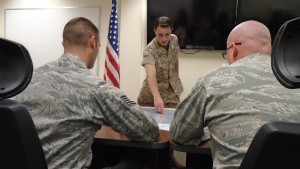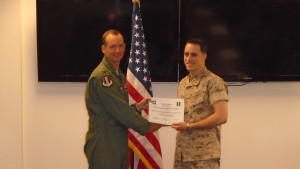2016-03-08 The F-35 is a first generation information age combat aircraft.
The USAF is training with this in mind, and has started the process of preparing the Air National Guard as well for the transition.
According to a piece published February 16, 2016, by Airman 1st Class Andrea Posey, the first air national guard airman have graduated from the F-35 intel school.
As the F-35A Lightning II prepares to fly north in 2020, the Vermont Air National Guard sent an Airman here to become the first National Guardsman to graduate from the Joint Strike Fighter program’s Intelligence Formal Training Unit.
Capt. Christopher Clements, 158th Operations Support Squadron intelligence officer, graduated Feb. 11, 2016, with seven other Airmen and U.S. Marines qualified in F-35-specific intelligence.
“[The course] was fantastic,” Clements said. “There were a lot of points for discussion for how they’re all going to work together to support the platform in the future.”
The mission of the 33rd Fighter Wing is to train outstanding professionals with a vision to take the F-35A to initial operations capability and beyond. To date, 62 students have graduated from the IFTU, and the school will expand to train an additional 10 students per class from all three military branches, to include the ANG and reserves.

During this five week course, students spend eight hours a day studying intelligence theory, systems and sensors, air to air combat, air to ground combat and mission planning and application specific to the Lightning II.
“The F-35 is an information hungry aircraft,” said Capt. Stephanie Fraioli, 33rd Operations Support Squadron intelligence instructor. “The information burden fifth generation technology places on pilots is significantly larger; therefore, the impetus is on F-35 intelligence support personnel to ensure flyers are prepared.”
The U. S. Air Force selected the 158th Fighter Wing in Burlington, Vermont, as the first Air National Guard unit to fly the Lightning II because of the ideal mixture of infrastructure to support operational training requirements of the jet, airspace and overall cost to the Air Force, according to Timothy Bridges, Deputy Assistant Secretary of the Air Force for Installations in a 2014 interview.
The VT ANG vision is to be innovative and provident in their approach to mission and resources by professionally developing their airmen and civilians. By sending Clements to the IFTU, the Vermont intelligence community believes they are taking the right step in accomplishing this vision.
“The technology capabilities of the F-35 require robust, in-depth training for our analysts,” said Lt. Col. Laura Caputo 158th Operations Support Squadron senior intelligence officer. “Captain Clements’ successful completion of this course paves the way and launches our shop down this road, ensuring our readiness when the jets arrive.”
The 18 F-35A’s headed to the VT ANG will replace 18 F-16CM Fighting Falcons assigned to the 158th FW. This exchange will offer joint training opportunities with F-15C Eagles from Barnes Air National Guard Base, Massachusetts, the 10th Mountain Division at Fort Drum, New York, and the CF-18 Hornets at Canadian Forces Base Bagotville in Quebec.
Eglin is one of three F-35 program training centers hosting the latest courseware, electronic classrooms, simulators, flight events and event-based maintenance training. Units at eight U.S. military bases currently fly the F-35 and benefit from these training centers. These installations include Eglin Air Force Base, Florida; Edwards Air Force Base, California; Nellis Air Force Base, Nevada; Hill Air Force Base, Utah; Luke Air Force Base, Arizona; Marine Corps Air Station Beaufort, South Carolina; Marine Corps Air Station Yuma, Arizona; and Naval Air Station Patuxent River, Maryland.
The Marines are operating the F-35 before the USAF, and started the process earlier.
In a story published on June 29, 2015, Staff Sgt. Marleah Miller wrote about the first USMC graduates from the the USAF’s F-35 intelligence course.
This is a good example of the joint nature of the program with training across the services and partners shaping a new 21st century combat capability.
EGLIN AIR FORCE BASE, Fla. – The first U.S. Marine Corps officer graduated the Air Force’s only F-35 Lightning II Intelligence Formal Training Unit course, June 24, on Eglin Air Force Base, Florida.
The formal course combines fifth-generation fighter-specific and general intelligence academics applicable to the F-35 and the low observable global strike mission. Completion of the F-35 IFTU curriculum fulfills all initial qualification training requirements, and students are assigned basic qualification status.
U.S. Marine Corps 1st Lt. Samuel Winsted, F-35B Lightning II intelligence officer, started his training at Eglin, May 18, 2015, learning the unique aspects of F-35 employment and intelligence support to the F-35 mission.

“It’s our job to help students understand what the F-35 can do and what it brings to the fight,” said Staff Sgt. Jeffrey Miskin, 33rd Operations Group F-35 IFTU instructor. “We have to change and modify our lessons so we can incorporate those changes program-wide as the F-35 program approaches initial operational capability.”
The Marine Corps will declare IOC with the F-35B, short take-off and vertical landing variant, this summer.
“Having Lt. Winsted here is significant because the Marine Corps doesn’t have a course equivalent to our F-35 IFTU course,” said Lt. Col. Bradley Turner, 33rd Operations Support Squadron commander. “It will absolutely increase their capability.”
Winsted will serve in a critical role assisting the Marine Corps’ F-35 program at Marine Corps Air Station Yuma, Arizona, as it becomes the first operational F-35B base.
“Now that I have my basic qualification status, I can provide the right information, scenario development and mission integration to the F-35B to the Marine aircrews at MCAS Yuma,” said Winsted.
The F-35 IFTU at Eglin provides reach-back support regarding intelligence support to other services’ F-35 squadrons.
“Hopefully, we will be able to teach more Navy and Marine intelligence analysts,” said Miskin. “That way, as a whole, we can all be on the same page as to what intelligence to provide and how they will support F-35 aircrew to complete the mission.”

